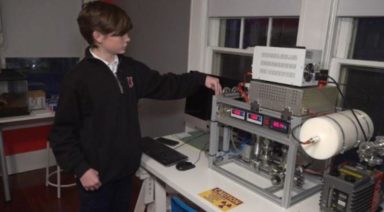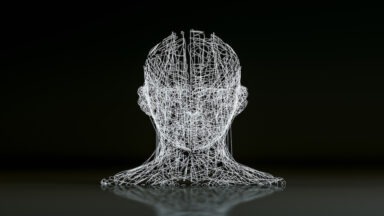Can You Really Charge a Crystal to Resonate Positive Energy?

It’s rare to have figured out and planned your career path in childhood, let alone a career within a niche subset of a scientific field, but that is exactly what Marcel Vogel did, having synthesized phosphors at the age of 12. In adulthood, he became a successful researcher for IBM with over 100 patents before he produced his seminal invention, the eponymous “Vogel Crystal,” used for dowsing, healing, and myriad metaphysical purposes.
Vogel had a near-death experience after suffering pneumonia at age six. After being pronounced dead, he was revived saying he experienced love and light while his heart stopped. This caused Vogel to struggle to assimilate back and reconcile with his life afterward. He soon found himself on an existential journey to which he found the answer after extensive praying. He said a voice told him he would be a phosphor chemist and make advancements in luminescence, a path he diligently followed.
Vogel worked for IBM for 27 years, creating the magnetic coating for hard disks used in all IBM computers — an invention that came to him in a dream. But it wasn’t until he was exposed to the work of Cleve Backster and his paper, “Do Plants Have Emotions?” that Vogel switched his focus of study to the power of crystals for spiritual use.

Source: marcelvogel.org
The Vogel Crystal
Intrigued by Backster’s study, Vogel conducted similar experiments of his own with plants. Using a Wheatstone bridge circuit, he measured the plant’s response based on his thoughts about ripping its leaves. He found that the plants acted like a battery, mirroring and storing his thoughts. If he projected thoughts about ripping one plant onto another, it picked up the energy. According to Vogel, this phenomenon could occur at long distances, even thousands of miles away.
Vogel applied this concept of charging something physical with thought and emotion to be focused and channeled. Having worked with liquid crystals, Vogel applied the concept behind their use in focusing lasers, to use them for focusing thought. After running numerous experiments on the conductivity of the energy of quartz he created the Vogel crystal, modeled after the Tree of Life with the measurement of its facets based on the angles of the Great Pyramid of Giza, 52 degrees, 51 minutes and 51 seconds.

The Vogel crystal works on subtle biological functions, based on the idea that energy resonates with water. Since our bodies are made of more than 70% water, the crystal becomes a tool for resonating positivity at a molecular level. The crystal itself doesn’t contain any intrinsic power, rather it transmits energy once it is charged, much like a laser focuses light.
The crystal has a receptive end that absorbs, coalesces, and amplifies energy that is then focused acting as a quantum converter. Vogel believed that the body contained numerous liquid crystal systems in our cell membranes, blood, and nervous system that would resonate with energy in the crystal.
Clearing and Charging a Crystal
Many crystals are purported to be Vogel crystals, however, there are only a few producers that know Vogel’s original method. When looking for a crystal, a person’s energy field is considered before the cutting and faceting process. Otherwise, one will typically have an intuition for which crystal is right for them.
Crystals can be cleared of negative energy by holding the crystal between the thumb and middle finger of your dominant hand, breathing in and holding your breath for a few seconds while thinking of clearing the crystal of any limiting energy, and then releasing your breath in a quick burst. This process is repeated for each facet.
A crystal can be charged by rolling it around and squeezing each facet until a slight charge is built up. This charge can be felt when the crystal becomes sticky from what is called a piezoelectric charge. With the acute angle facing away and the index finger placed on the tip, the breath is drawn in and pulsed out with the intent of putting all the love of your heart in the crystal. According to Vogel, this captures a fragment that can resonate in the crystal that promotes positive energy.
The Mystery of Torsion Fields

Russian scientist Nikolai Kozyrev was considered a prodigy. In 1925, at age 17, he published his first scientific paper, which focused on astrophysics and the atmosphere of the sun and other stars. It was met with great acclaim by other scientists.
At age 20, he graduated from the University of Leningrad with degrees in physics and mathematics. By age 28, he was a college professor and distinguished astronomer. To the science community at large, this promising young physicist disappeared for the next 11 years.
Nikolai Kozyrev: Russian Concentration Camps
While Korzyrev was enjoying a successful career as a professor and researcher, Josef Stalin, leader of the Soviet Union, was feeling threatened by scientists whom he perceived were independent thinkers. He was concerned they would see through his propaganda program. To prevent this, in 1936, he arrested them and sent them to concentration camps. Nikolai Kozyrev was among those imprisoned. There wasn’t much for him to do during the long 11 years he spent in the camps except to observe, meditate, and think.
During his imprisonment, Kozyrev was enthralled watching bacteria grow and noticed it grew in a perfect spiral. This led him to conclude that all life-forms likely draw off of an unseen spiraling source of energy. This energy is as important to maintenance and growth of life as are “eating, drinking, breathing, and photosynthesis.”
Kozyrev also concluded that this spiraling energy and growth is how time works, with the Earth orbiting in space by way of a “complex spiraling pattern.”
As the Earth rotates on its axis as it orbits the sun, it releases energy, or torsion waves, that propel it through space. The torsion waves travel at speeds faster than the speed of light. These torsion fields are actually “waves of time” which also cause ripples in gravity. Indeed, some scientists now believe that “electromagnetism, gravity and torsion waves are all members of the same family; they are just different forms of ether vibrations.”




































